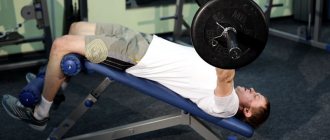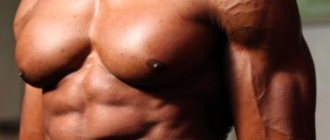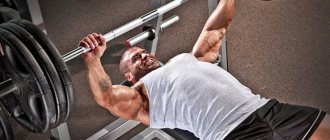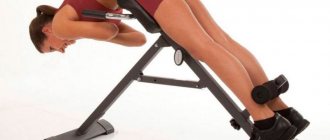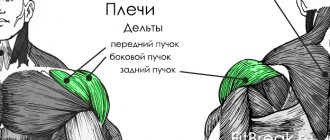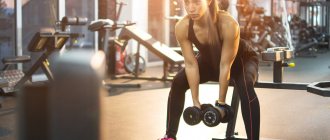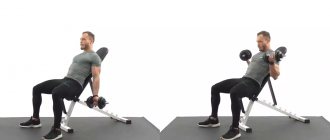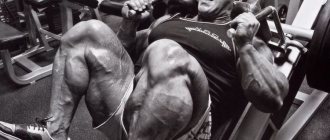A little anatomy
We will not study every detail in the anatomical atlas, but on the contrary, we will focus on the main thing. We are interested in the pectoralis major muscle, namely the clavicular part (“top of the chest” in rocking parlance) and the sternocostal muscle (“middle” and “bottom”).
It is clear that in “chest” exercises the bundles of one muscle group work together, but the degree of activation of different segments depends on the direction of movement.
For example, the top of the chest is more involved in the incline bench press (head up), the middle in the traditional bench press, and the bottom in the dip.
If you pump your chest only with a regular bench press, you will not achieve full and balanced development.
Crossing hands on blocks (crossovers)
Despite the fact that crossovers are a specialized exercise, sets of equipment for their implementation are available in almost all gyms. It is considered a more effective exercise for developing the lower bundles of the pectoral muscles due to the fact that the arms are tense throughout the entire range of motion.
There are two options for performing this exercise: standing straight and bending forward at an angle of 45 degrees. In any case, at the lowest point of the movement, the hands must touch.
Valuable Instructions
Before moving on to the description of the exercises and program, let’s note the importance of the “brain-muscle” connection. Mindful execution of a movement is more effective than mechanical training: in a study evaluating the benefits of verbal instructions, they were found to increase the degree of activation of the pectoral muscles by 22%. That is, in the group of subjects to whom the scientists gave direct instructions to concentrate on a specific muscle, activation of that muscle was higher (with the same weight in the same exercise). True, at maximum weights (80% of 1RM when working on triceps), this effect was no longer detected.
Comprehensive breast restoration program after breastfeeding
After the end of the lactation period, the breasts, as a rule, return to their previous sizes, but their shape still changes, which does not suit all women. A comprehensive recovery program will help make your breasts firmer:
- Masks and nourishing creams. Various lifting masks and creams are quite effective in restoring skin tone and improving blood circulation in the breast. They can be done at home or in a beauty salon. Masks based on lemon, orange, green tea and rosehip juice are good for toning. In combination with other procedures, masks help tighten the breasts after childbirth.
- Physical exercise. Performing regular breast exercises is the fastest and most effective way to restore its shape after childbirth. Intensity and load are selected individually. If possible, sign up for a fitness club, where a trainer will help you create a workout program. If your baby takes up all your free time, do the exercises at home. The main thing is that the classes are regular, and you choose the load yourself, focusing on your feelings.
The best exercises for chest
1. Incline dumbbell press (head up)
The upper chest lags behind for many people, so you need to put the clavicular fascicle exercise first.
Pros of the exercise:
1. More range of motion (than with a barbell) means more incentive for growth (research, ).
2. The dumbbell also activates the target bundles to a greater extent: Bret Contreras, in his EMG experiment, found that the dumbbell incline press was most effective for the upper chest.
3. Pressing two dumbbells prevents asymmetrical development (the strong side does not take away the load from the weak, as in the case of a common bar).
The optimal tilt angle is in the range from 30 to 56 degrees; Everyone must choose for themselves, as it depends on individual characteristics.
2. Bench press (on a horizontal bench)
The most popular exercise of all rocking chairs and in scientific experiments turns out to be the most effective for the chest as a whole (,).
Although this movement activates the mid-chest more, it allows for the use of higher working weights (which also correlates with mass).
But there is a nuance - some people cannot pump up their chest with a barbell bench press, since the load is intercepted by the triceps and anterior deltoids. The next option is for you.
2.1. Dumbbell bench press (on a horizontal bench)
Dumbbells allow you to activate your pecs more strongly (Bret had this option among the leaders for the middle of the chest), as well as unload the overly active triceps.
Plus a couple of the same advantages of separate apparatuses: greater range of motion, less imbalance in development.
3. Push-ups on parallel bars or bar
The best exercise for working the lower chest. The specific design option should be selected individually: some people feel more load on parallel bars, some prefer angled handles, and for others a bar on racks is enough.
Pay attention to the features of the technique: to work the chest, you should lean forward a little (performing with a vertical body shifts the load to the triceps). For beginners, this exercise may be too difficult, but experienced athletes will have to hang additional weights on their belts.
4. Push-ups (with a tourniquet)
It is very useful (for hypertrophy) after heavy barbell/dumbbell bench presses to “finish off” the chest with the good old push-up from the floor, adding loads using a rubber expander.
By the way, studies show the high effectiveness of push-ups for strength: after 5 weeks of the experiment, participants who did push-ups with a tourniquet gained about the same amount in their bench press as the group that worked only on the bench press (study).
You just need to find a set of resistance bands of varying elasticity to gradually increase the intensity of the exercise to increase strength and mass.
5. Bringing your hands together on blocks (top to bottom)
And we’ll finish the training with an isolating movement for the sternocostal bundles (middle and bottom of the chest).
It activates the target muscles as well as the bench press, and - the main advantage of isolation - you can kill yourself to failure with minimal risk of injury.
Also, in the version on blocks, you can increase the range of motion - cross your arms without losing the load (which will not happen with free weights).
Things to remember when doing physical activity
Have you become familiar with the exercises that pump up your chest and started doing them, but there are no results? We recommend considering the main mistakes that beginners make when performing physical activity.
Exercise in Moderation
Many people believe that the more they pump their chest, the faster their muscle mass will increase and the larger their muscles will be. In fact, it has a negative impact on growth. The muscle becomes larger during rest, when the tissue is restored after active training. There are several tips on how to properly pump up your pectoral muscles and not overtrain:
· Do sports no more than 2 times every 7 days. In between, do physical exercises on other parts of the body;
· Do not exercise for more than 45 minutes, as this may cause muscle size and strength gains to begin to regress.
Workout to the max
While performing exercises, the athlete must not only know how to properly pump the chest muscles, but also put all his strength into this process. “Challenge yourself”, do the maximum that will not negatively affect the condition of your muscles, ligaments and joints.
Don't know what weight is appropriate? Try doing exercises that involve replacing dumbbells. Use the main weight for the last 8-10 reps. This will allow you to sweat and tense your muscles. There are several recommendations on how to effectively pump up the pectoral muscles:
1. Can't do more than 5 reps? Reduce weight. As strength increases, add weights.
2. Doing 10 reps lightly? Increase the weight until you feel a slight burning sensation in the muscles.
Is proper technique important?
It is better if there is a trainer who will show you how to properly pump your arms and pectoral muscles. To perform each exercise, it is important to have strength, not impulse. If you want to achieve a certain effect, you should feel a burning sensation in a specific area during training.
What happens if a person does not know how to properly pump up his chest muscles? This problem can lead to injury to muscles, tendons and ligaments. Most often it depends on:
1. Incorrect technique.
2. Heavy weight. Can't bench press? Remove additional weights.
How to eat for muscle growth?
Have you read all the information on how you can pump up your pectoral muscles, but don’t know anything about nutrition? There are several recommendations for eating that will make your workouts effective:
1. Refusal of foods that are too high in calories. Don't think that the more food you eat, the stronger your muscles. This is a misconception. Calories are needed to create energy, which is used during exercise. If a person consumes in excess of the norm, fat reserves will increase, not muscle mass. Say “no” to foods with empty carbohydrates (pasta, cakes, cookies). Avoid fried foods and fast food.
2. Eating enough protein. It is found in lean meat, eggs, dairy products, nuts, and beans. Protein serves as a “building material” for muscle fibers. Therefore, if you want to have a toned figure, eat enough food that contains it.
3. Taking supplements. You can buy a protein shake. The supplement is considered effective and natural.
Recommendations and Cautions
If you have learned how to pump up the chest muscles, then read the recommendations below:
· take more vitamins;
· try to consume sugar only from fruits;
· warm up before training;
· Monitor the number of calories you consume per day. Food deficiency can lead to undesirable consequences;
Concentrate on doing physical activity. If you don’t feel heaviness in your muscles, do the exercise more slowly or increase the weight;
· sign up for the swimming pool. Swimming is a great way to develop your body muscles;
· don’t forget about training if there is no result after a week. All will be! But not at once;
· drink enough water;
· charge yourself with music during workouts;
· don't feel sorry for yourself;
· Pay attention to one muscle group every 3-4 days or until the pain goes away. Train other parts of the body too;
· try to sleep 8 hours, muscles need rest, then growth will occur;
· Perform physical activity correctly. Is training too easy for you? Add weights.
Exercise order
The above protocol is suitable for most people who are missing the top of their pectorals, but the middle and bottom are growing normally. A number of studies show that exercises for lagging groups/bundles (,) should be given first place in the program.
If you lack the middle (“thickness”) of your chest, then rearrange the exercises:
- Barbell/dumbbell bench press (on a horizontal bench): 3 sets of 6-10 reps
- Incline dumbbell press (head up): 3 sets of 6-10 reps
- Dips (or bar): 3 sets of 8-12 reps
- Push-ups (with a tourniquet): 3 sets of 6-12 reps or until failure
- Reduction of hands on blocks (from top to bottom): 3 sets, number of repetitions from 10 to maximum
And if the bottom lags behind, then:
- Dips (or bar): 3 sets of 8-12 reps
- Barbell/dumbbell bench press (on a horizontal bench): 3 sets of 6-10 reps
- Incline dumbbell press (head up): 3 sets of 6-10 reps
- Reduction of hands on blocks (from top to bottom): 3 sets, number of repetitions from 10 to maximum
- Push-ups (with a tourniquet): 3 sets of 6-12 reps or until failure
Bench press
Stanislav Lindover
master of sports in bodybuilding
A person most often gets injured when removing a projectile from the racks and putting it back. It is best if there is a belayer next to you. Its main task is to avoid losing control of the barbell.
Execution technique
- We lie down on the bench so that the bar is at eye level.
- We spread our legs slightly to the sides and rest our feet on the floor.
- We bend a little in the lower back.
- Raise the barbell while exhaling. The grip should not be too narrow or too wide.
- As you inhale, lower the barbell to your chest; it should be approximately in the middle of your chest.
Important:
if you are practicing at an advanced level, the amplitude of execution should be shortened.
What to do if your biceps don’t grow, and how to pump them up correctly? Coach tips
How to pump up sculpted arms? Arnold Classic champion workout for biceps and triceps
